The Father of the Digital Synthesizer
Mar 23, 2015 · 13,660 views
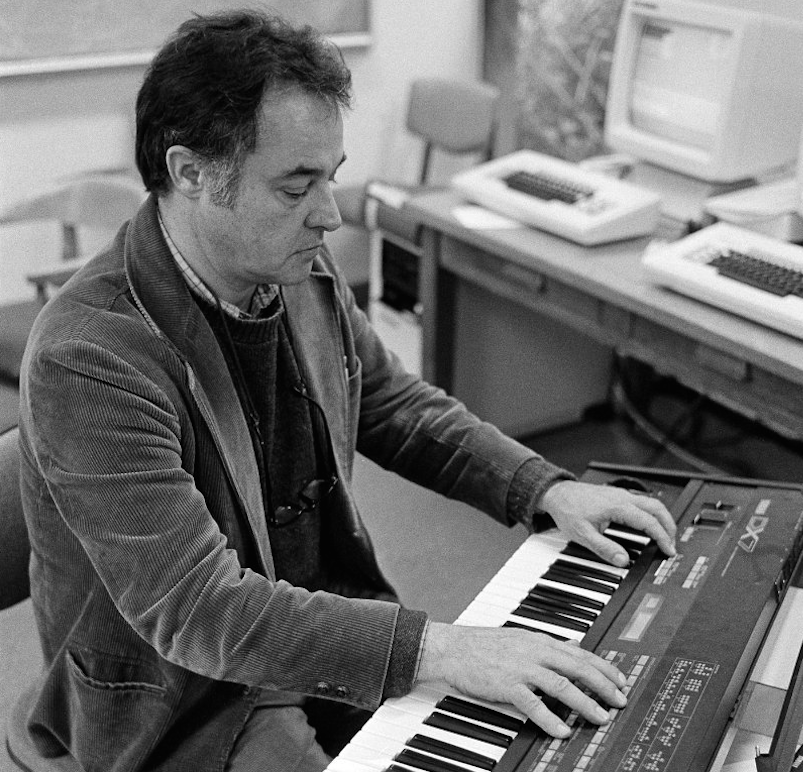
“I was aware that I was probably the first person to ever hear these sounds, and that what I was hearing was something musical that had probably never been heard by anyone before — at least, not by anyone on this planet.”
— John Chowning, Inventor of FM Synthesis
— John Chowning, Inventor of FM Synthesis
Long before Stanford University was considered a technology powerhouse, its most lucrative patent came from an under-spoken composer in its music department. Over the course of two decades, his discovery, "frequency modulation synthesis," made the school more than $25 million in licensing fees.
But more importantly, FM synthesis revolutionized the music industry, and opened up a world of digital sound possibilities. Yamaha used it to build the world’s first mass-marketed digital synthesizer — a device that defined the sound of 80s music. In later years, the technology found its way into the sound cards of nearly every video game console, cell phone, and personal computer.
Despite the patent’s immense success, its discoverer, Dr. John Chowning, a brilliant composer in his own right, was passed over for tenure by Stanford for being “too out there.” In Stanford’s then-traditional music program, his dabblings in computer music were not seen as a worthy use of time, and he was largely marginalized. Yet by following his desire to explore new frontiers of audio, Chowning eventually recontextualized the roles of music and sound, found his way back into the program, and became the department chair of his own internationally-renowned program.
This is the story of an auditory pioneer who was unwilling to compromise his curiosity — and who, with a small group of gifted colleagues, convinced the world that computers could play an important role in the creation of music.
Echoes in Caves
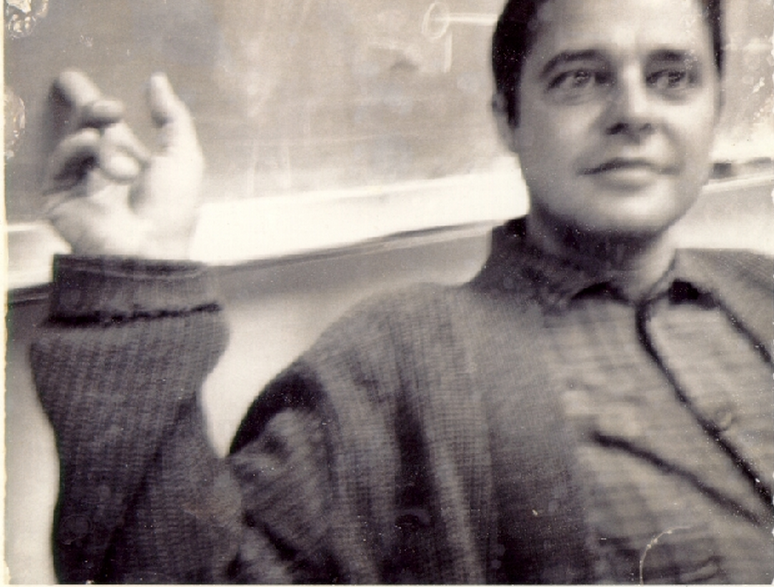
John Chowning in his youth
John M. Chowning was born in the Autumn of 1934, just as New Jersey’s Northern Oak leaves were turning yellow. In the thralls of the Great Depression, the Chownings did everything they could to provide a modest household for their two sons and daughter — though it was a space “devoid of music.”
Despite this, the young Chowning felt mystically drawn to sound. “I loved caves as a child,” he reminisces. “I would go hiking up in the Appalachian Mountains, go into these caves, and just listen to the echoes. They were mysterious, magical places.”
It was the world’s natural acoustics that inspired Chowning to take up the violin at the age of eight, though the instrument never quite captivated him. After migrating to a Wilmington, Delaware high school in the 1940s, “a great music teacher” exposed him to his true love: percussion.
Fully versed in reading sheet music, Chowning was initially enlisted to play the cymbals, but soon graduated to the drums. This became his “full-hearted passion,” and before long, he was a competent jazz percussionist. “My whole world,” he says, “was music, music, music.”
Upon graduating, Chowning served in the Korean War and, due to his skill, was enlisted as a drummer in one of the U.S. Navy’s jazz bands. “There were so many good musicians there who really pushed me to perform — musicians who were, at the start, much better than I,” he admits. “There was a lot of pressure for me to get my chops up.” For three years, he toured Europe with the group, catering to the culture’s growing interest in the newer movements of jazz.
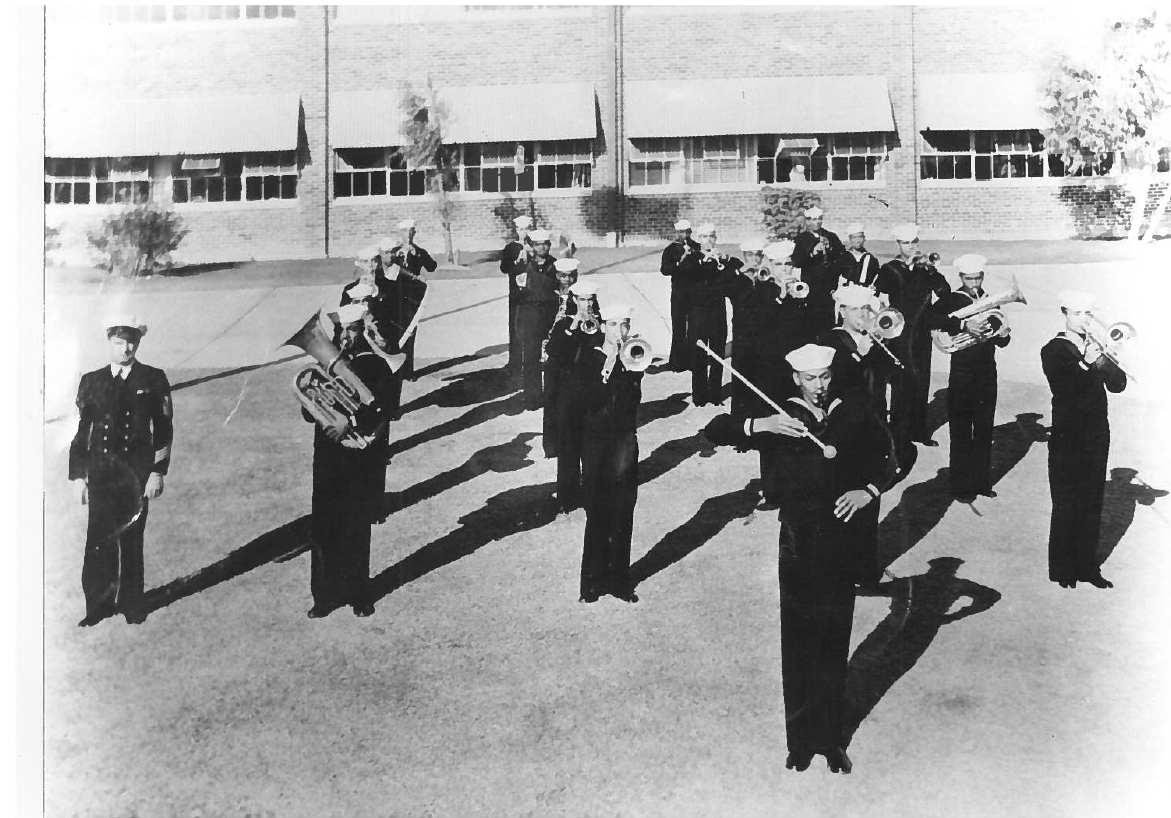
A U.S. Navy Jazz band (c.mid-1940s)
He returned to the U.S. with a free college education on the GI bill, and attended Wittenberg University, a small liberal arts school in Ohio, at the behest of his father. Here, he immersed himself in the “contemporary composers” — Béla Bartók, Igor Stravinsky, Pierre Boulez, and the like. “I got very comfortable playing by myself,” he adds. “Improvisation was my path to new music.”
It was a path that would eventually lead him back to Europe.
After graduating In 1959, Chowning wrote a letter to Nadia Boulanger, a famed French composer who taught many of the 20th century’s best musicians, and expressed his great interest in studying under her. Chowning was accepted, and he and his wife moved to France where he joined 40 other gifted students . For the next two years, he met with her once a week for intensive studies. “It was a very fruitful time for me,” he recalls. “I learned a lot about harmony and counterpoint.”
But Chowning’s biggest revelation — the one that changed his life — came when he attendedLe Domaine Musical, an “avant-garde” concert series in Paris that often featured experimental music:
“Some of the music involved loudspeakers. Hearing what some of these composers were doing was life-changing — Karlheinz Stockhausen had a four-channel electronic piece involving [pre-recorded] boys’ voices. The spatial aspects caught my attention: that one could create, with loudspeakers, the illusion of a space that was not the real space in which we were listening.”
While Chowning sat awestruck, the rest of the attendees — mostly “traditionally-minded” musicians and students — “booed, screamed and whistled in disapproval after the piece was over.” Though electronic music was just emerging in Europe at the time, it wasn’t yet popular or widely accepted, especially among trained musicians.
In his next meeting with Boulanger, Chowning sheepishly admitted his interest in “loudspeaker music,” expecting to be ridiculed. Instead, the well-versed teacher encouraged him to pursue it. But as Chowning soon learned, electronic music was “highly dependant on special studios with technical knowhow.” Though he yearned to reproduce it and explore it, he did not have the financial or technical ability to do so.
“When I heard this music in Paris, I thought, ‘I could create music if I could control those loudspeakers,’” recalls Chowning. “But it was disappointing to learn they were dependant on such high tech.”
Stanford’s Misfit Composer
With no way to pursue his newfound interest in electronic music, Chowning returned to the United States, enrolled in the music doctoral program at Stanford University, and became involved as a percussionist in the school’s symphony. Gradually, he began to resign himself to a more traditional repertoire.
Then, in the winter of 1963, during Chowning’s second year of studies, a fellow percussionist handed him a page ripped out of Science magazine. Chowning hardly glanced at it before stuffing it in his pocket — but two weeks later, he rediscovered it and gave it a read. Thearticle,“The Digital Computer as a Musical Instrument,” was written by a young scientist at Bell Laboratories named Max Mathews. At first, Chowning couldn’t really make sense of it.
“I had never even seen a computer before, and I didn’t understand much,” admits Chowning. “But there were a couple of statements that got my attention — especially that a computer was capable of making any conceivable sound.”

Schematics from Mathews’ paper; Stanford Special Collections Library
The article was accompanied by several diagrams that were, at first, beyond Chowning’s comprehension, but his curiosity compelled him and he soon pieced together an understanding:
“A computer would spit out numbers to a digital analog converter, which would then convert numbers into voltage proportionally. The voltage went to loudspeaker...It made me think back to all those big studios in Europe. I thought, ‘If I could learn to generate those numbers and get access to a computer and a loudspeaker, none of that expensive equipment would be required!’”
Though Chowning was a “mere” percussionist with no discernable electronics skill, he didn’t flounder. Instead, he decided to take advantage of Stanford’s “pretty good computers” by enrolling in a programming class. “I had to prove I could do it,” he says, “and it really wasn’t too difficult.” Using a bulky, but then-new Burroughs B-5500, he learned to code in ALGOL.
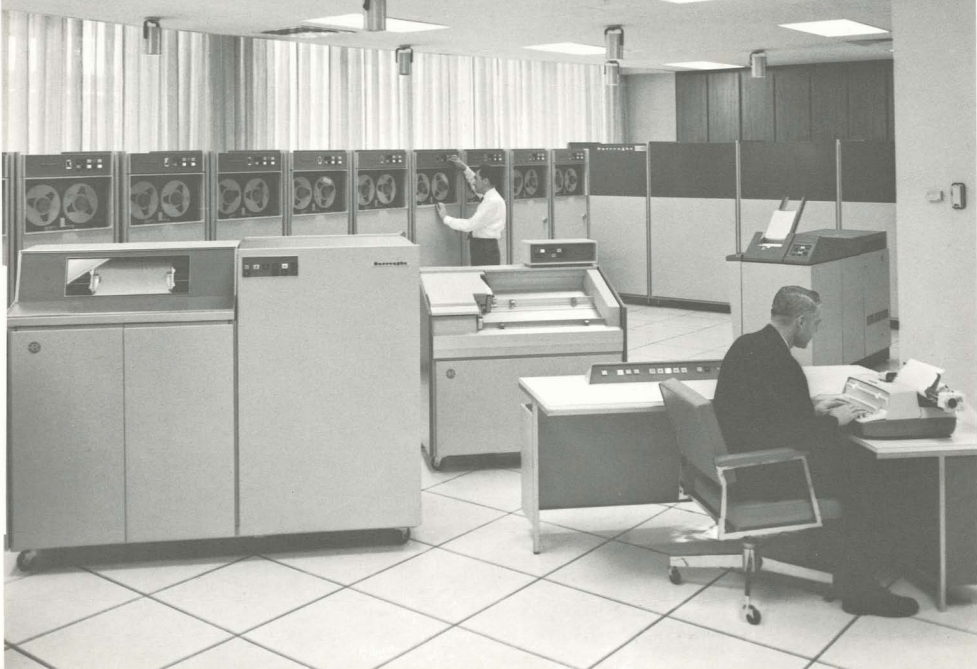
A Burroughs B-5500 system: an early computer enlisted by Chowning for music
By the Summer of 1964, he’d acquired some basic proficiency with the machine and language, and decided to journey to Murray Hill, New Jersey to meet Max Matthews, the man who’d written the paper that had inspired him. When Chowning arrived, Matthews was pleasantly surprised, and took the curious musician under his wing. Chowning recalls:
“I told him that I wanted to use his program, ‘Music 4,’ and he gave me a big box of punch cards. Each represented a particular waveform — sinusoidal, triangular wave, and whatnot. Then, another card would tell computer how to connect these, and modulate frequencies. You could generate thousands and thousands of periods of a sine wave with just a couple of punch cards.”
At the time, Stanford was far from the risk-taking institution it is lauded as today — and its music program was especially traditional and rigid. As Chowning had experienced in France, most of his college colleagues scoffed at the unfamiliar, foreign concepts of computer music.
“It was against what the department said music was; they said I was dehumanizing music!” laughs Chowning. “My response was, ‘Perhaps it’s the humanization of computers.’”
Despite the music department’s backlash, when Chowning returned to Stanford with Matthews’ box full of punch cards, he found a supportive mentor in composition professor Leland Smith:
“[Leland Smith] was the one person in the music department who said, ‘Go ahead and tell me what you learn,’” recalls Chowning. “It was a very traditional department at the time, with a lot of interest in historical musicology and performance practice; what I was doing was pretty far from the central interest of the department, but Leland encouraged it.”
Just as Chowning delved into the relatively unknown world of computed music, Smith took off to Europe for a one-year sabbatical. But before he left, he made Chowning promise him one thing: “Show me what you’ve learned when I return.”
The Discovery of FM Synthesis
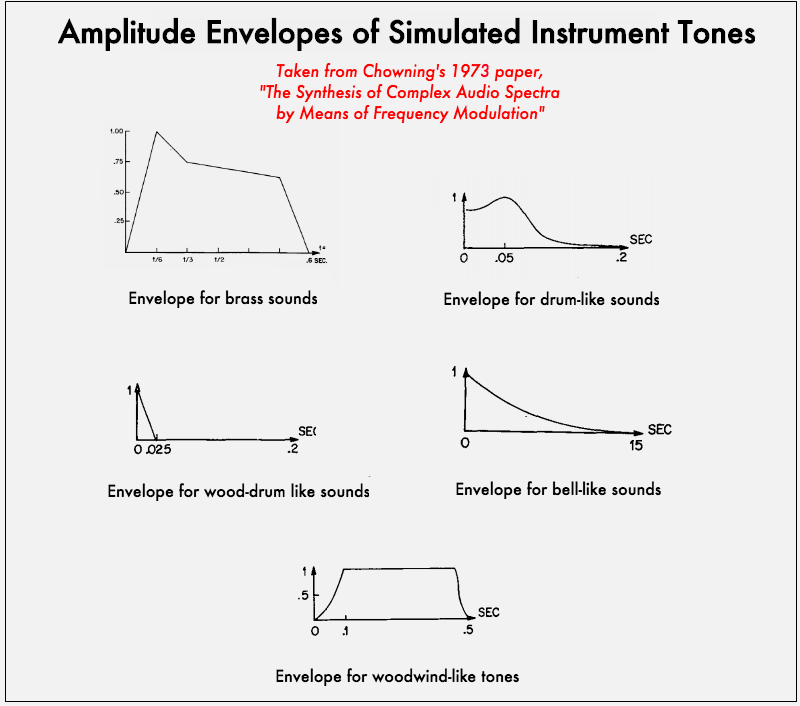
Years before, when Chowning was studying in Paris, he had come across Bird in Space, a bronze sculpture by Romanian artist, Constantin Brâncuși. “I remember looking up at this beautiful, modernist work: simple elegant, but complicated,” he reminisces. “All the lines extended one’s eyes into a space that was absolutely gripping in its effect.”
He was driven, in that moment, to “create spatial illusions” — to create sounds that would move like the lines in Bird in Space.
In the late months of 1964, while Leland Smith was abroad, Chowning had an idea: he’d create a “continuum” to move sounds in a 360-degree space. At the time, not much was known about why or how sounds moved in space; Chowning’s first challenge was to create sounds that “not only had angular distribution, but also radial distance.” In order to achieve this, he realized that he’d need to fully immerse himself in acoustics, as well as the science behind auditory perception.
For the next two years, the rogue musician hit the books. “I had to learn much about audio engineering and perception, psychoacoustics, and the cognition of sound (the difference between something loud and close, and loud and far),” says Chowning. “I did it all so that I could accomplish my composition goals.”
***
By 1966, Chowning’s time as a Stanford Ph.D. student had come to a close. With strong references from his adviser, Leland Smith, and others in the department, he joined the staff as an assistant professor of composition.
Increasingly, Chowning spent much of his free time in the “dungeons” of Stanford’s artificial intelligence lab, where he could access computers and analyze the properties of the sounds he was working with. It was here, late one night in the Autumn of 1967, that Chowning had an unintentional breakthrough:
“I was experimenting with very rapid and deep vibrato [a music effect characterized by a rapid, pulsating change in pitch]. As I increased the vibrato in speed and depth, I realized I was no longer hearing instant pitch and time.”
To put this in digestible terms, any given sound — say a B-note on a violin — has a distinctive timbre (identifying tone quality), and produces a sound wave. Sounds can be manipulated with certain effects, which are either natural (playing an instrument in a giant room provides reverberation and/or echo), or imposed (by manipulating a note on a violin, one can produce vibrato, or a wavering sound). The sound cards in Chowning’s possession were able to reproduce these effects digitally.
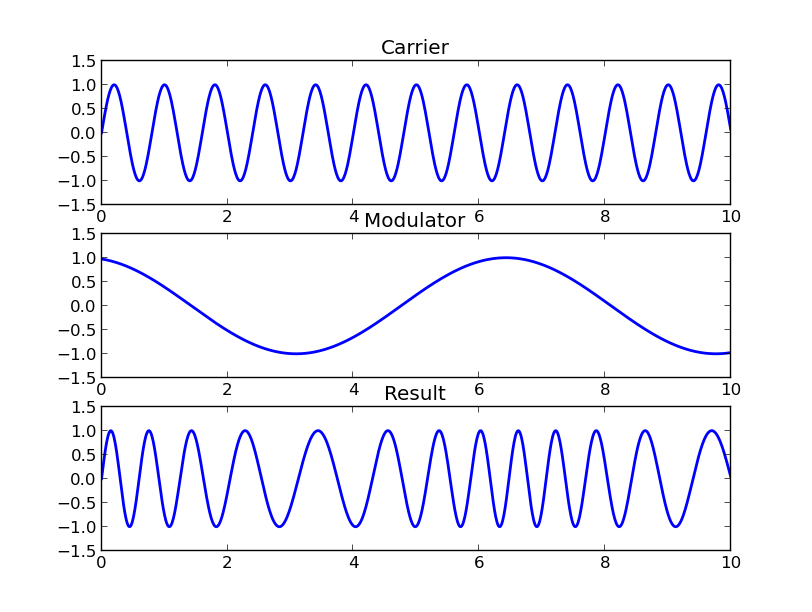
Chowning found that by using two simple waveforms — one, the carrier, the frequency of which was modulated by the other — he could create a very rapid “vibrato” capable of producing complex, harmonic or inharmonic tones depending on the waveforms’ frequencies and the depth of the modulation. He called this “frequency modulation synthesis,” or FM synthesis. The sounds this method produced were entirely foreign:
“I was aware that I was probably the first person to ever hear these sounds, that what I was hearing was something musical that had probably never been heard by anyone before — at least, not by anyone on this planet.”
“It was 100% an ear discovery: I knew nothing about the math behind it,” adds Chowning. “It was a product of my musical training.”
Though he instantly understood the gravity of what he’d discovered, Chowning realized that, in order to fully grasp its applications, he’d need to understand the math that was making these sounds possible. This was a problem: at 30 years of age, his last math course had been freshman algebra — and even then, he’d had to “beg for a passing grade.”
But Chowning was driven forward by a deep-rooted desire to explore music, to reach into the mires of unexplored sound. And he had help: first from his “angel,” David W. Poole, an undergraduate math major who taught him how computers worked, and then from the scientists and engineers at Stanford’s Artificial Intelligence (AI) Lab. “There was excitement in the discovery,” he admits, “but the potential of using it in my music is what drove me — not discovery, or invention.”
So, the music professor spent innumerable hours delving into math books, and consulting these researchers in the AI Lab. “Gradually,” he says, “I learned to understand the FM equation through programming and math, and learned that it had an importance not seen by many people.”

The “importance” was that FM synthesis could be applied to produce highly accurate digital replications of real instruments. More boldly put, it could open up musicians to a new world of sound customization.
But Chowning couldn’t neglect the main duties of his job. Like all professors in the music department, he was required to compose regularly, with the expectation that his work would receive peer recognition. He also had teaching duties to maintain, which consumed much of his time. While juggling his responsibilities, he spent the next four years working on FM synthesis, and replicating the sounds of various instruments.
Dr. Chowning’s Stanford Experience
By 1970, Chowning had succeeded in using FM synthesis to mimic various tones — drum sounds, vocals, brass — in a somewhat rudimentary form. When he passed his finding along to Max Mathews, the Bell Labs scientist he’d been inspired by, Mathews “fully understood” the importance of the discovery; with the endorsement of John Pierce, then-director of research at Bell Labs, Mathews suggested that Chowning apply for a patent.
In those days, innovative Stanford professors had a choice: they could develop their inventions independently, and assume all of their own financial and legal risk, or they could sign it over to Stanford’s Office of Technology Licensing (OTL). The OTL, which Stanford had just created, was the safer bet for Chowning: it would absorb all of the risk, bear the monetary burden of trying to license the technology (some $30-40,000), and would allow him to be involved in the process. The downside was that the university would get the lion’s share of the income from the patent, and would only pass a small sum on to the inventor himself.
“I didn’t want to deal with lawyers — I wanted to do my music,” defends Chowning. “I didn’t care about the money as much as I cared for my compositions. It was natural for me to say, ‘Please take it.’”
For a transactional fee of $1, Chowning signed the patent for FM synthesis over to Stanford’s OTL, which then began the long process of courting instrument companies.
Meanwhile, Chowning bunkered down and focused on integrating his discovery into his own music. Sabelithe, a piece which he’d begun in 1966, but completed in 1971, was the first composition to ever feature FM synthesis. If you listen closely between the 4:50 and 5:10 mark, you’ll hear a drum-like tone gradually transmogrify into a trumpet sound:
A year later, he presented Turenas, the first electronic composition to feature the “illusion of sounds” moving in a 360-degree space. “Normally when a composer puts up a work, there are a couple string quartets , a symphony or two, chamber music,” says Chowning. “I had very little — just a computer and some speakers.”
Though Chowning remembers the day of the composition’s premiere as “the realization of [his] dreams for many years,” his contemporaries weren’t as smitten. Years before, as a young student in Paris, Chowning had witnessed a room full of traditional composers boo an electronic musician’s performance; now, he was the man being scrutinized, and though the attendees weren’t the rowdy type, they exhibited the same breed of non-acceptance for what this new music. “What I was hearing in Turenas was not what the composers who were asked to come evaluate my work were hearing," he says. "What sense does sound moving in space make to people used to orchestral, traditional sounds? Universities are conservative — they move, but slowly — and it’s not popular to deviate from tradition.”
Despite his important output in the early 1970s (which also included an extensive academic paper mapping out FM synthesis and its exciting implications), Chowning soon found himself on the chopping block.
Seven years into his role as an assistant professor, it was time for him to take his sabbatical. “During this time, Stanford either promotes you or tells you to find work elsewhere,” says Chowning. “While I was on sabbatical, I was told I would not be teaching at Stanford anymore.” Though a reason for this decision was never provided, Chowning admits that the copious time he spent “developing a computer music system” was not perceived as a value add by the institution.
At first, this was devastating news for the young academic:
“It was a big problem when I was let go from Stanford. I had a young family and I had to figure out how I was going to support them. But I still felt like I had to pursue what I started. It wasnt worth giving up. I was in a digital world, but the whole process was intensely musical. Programming and creating sounds, and figuring out how the two relate — all of that was, for me, the point.”
As if on cue, the famous French composer Pierre Boulez contacted Chowning and offered him an advisory position in Paris. Boulez was, at the time, “a major figure in music” — the conductor for both the New York Philharmonic, and the BBC Orchestra — and had just been commissioned by France’s prime minister to create a national institution for experimental music research. It was his hope that the resulting project, IRCAM, would be in the interest of Chowning.
Chowning jumped at the opportunity, and soon found himself back in Paris, assisting in the development of the program.
***
As Chowning revelled in his new role, Stanford struggled to lease the FM synthesis patent. They approached all of the major organ companies, but none of them had the technical ability to grasp the discovery’s implications. Chowning’s discovery was ahead of the industry’s learning curve.
“Hammond, Wurlitzer, Lowry — they’d come around take a listen, and say, ‘That sounds good!’” recalls Chowning, who learned of these interactions later on. “They understood the abstract, but had no knowledge of the digital domain or programming. All said no.”
As a last resort, Stanford contacted Yamaha, a Japanese musical instrument manufacturer which, at the time, had already begun investigation into the digital domain for a distant future. And as luck would have it, the company gave the patent a chance.
“Yamaha sent out a young engineer to Palo Alto,” Chowning says, “and in ten minutes, he understood [our technology].” In fact, Yamaha understood it so well that they decided to sign a 12-month licensing agreement and figure out if it was something that could be beneficial to them commercially.
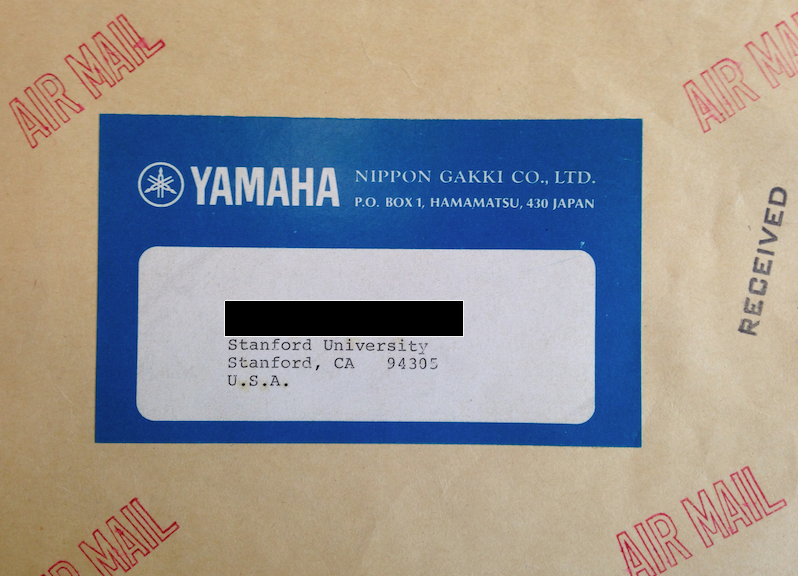
An early negotiation letter from Yamaha to Stanford; Stanford Special Collections Library
By early 1975, it’s likely that Stanford began to realize it had made a mistake by letting Chowning go. Not only did his patent show promise of making the university “tens of thousands of dollars a month,” but he had been swiftly snatched up by one of the biggest names in music to advise the development of the world’s most advanced digital music center in Paris.
With its tail between its legs, Stanford approached Chowning and extended an offer to return, this time as an research associate. Chowning agreed.
Back in his old office, Chowning wasted no time in redefining the school’s music department. With a small team of colleagues — John Grey, James Moorer, Loren Rush and his old adviser Leland Smith (then busy developing the SCORE music publishing program) — he proceeded to found the Center for Computer Research in Music and Acoustics (CCRMA, pronounced “karma”). The goal of CCRMA was simple: “it was a coherent group of people working together toward the synthesis, processing, spatialization and representation of sound.” It was also, by all accounts, the first program of its kind in the United States.
But really, says Chowning, CCRMA was a manifestation and extension of the ideas and projects he’d started more than a decade before, as a graduate student. Except there was a difference: while his efforts had once been disregarded and underappreciated, they were suddenly of the utmost importance to Stanford and its new patent licensee.
How Yamaha and Chowning Built the Modern Synthesizer
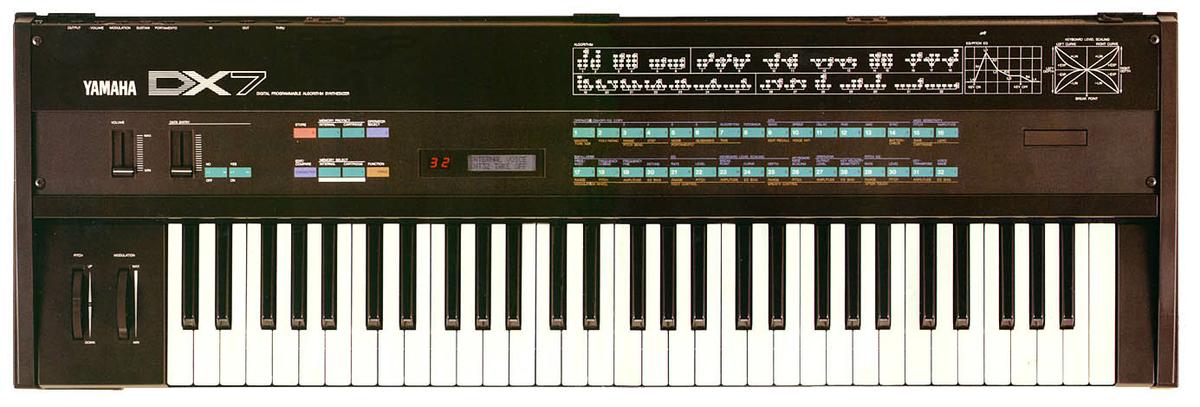
A Yamaha DX7: the synth that changed music forever
Since licensing FM synthesis in 1974, Yamaha had been in constant communication with Chowning and Stanford’s Office of Technology Licensing.
For years, analog synthesizer instruments had ruled the market. But they came with their fair share of shortcomings (or unique quirks, depending on who you talk to). From the 1950s to the early 1960s, electronic instruments were limited by their dependance on magnetic tape as a means of producing and recording sounds. Even newer developments in the mid-1960s, like the Moog or the Mellotron, were fickle: notes sounded different each time they were played, and there were often variations in pitch and amplitude. Most woefully, each individual note played was recorded “in isolation” — that is, few instruments had the ability to polyphonically produce sound.
Efforts to digitize the synthesizer had been made in previous decades, but were thwarted by the gargantuan size of computers and memory cards, and the fact that it took up to 30 minutes just to hammer out a few measures of music. But with semiconductor technology improving rapidly by the mid-1970s, it became feasible that Chowning’s FM synthesis technology could fit on a reasonably-sized computer chip.
Working with Chowning’s technology in 1974, Yamaha successfully produced its first prototype, a machine called MAD. Though it was just a proof, and nowhere near a product that would appear on the market, Chowning saw the team’s potential.
“It was clear right away that Yamaha’s engineers were masterful,” he says. “They put together these instruments quickly, and made great strides on my work. it was a very good relationship.”
Over three years of licensing FM synthesis, Yamaha, in tandem with Chowning, gradually improved the realistic qualities of their “timbres,” or sound effects. This level of commitment is evident in an excerpt from a July 1975 letter from Yamaha to Chowning:
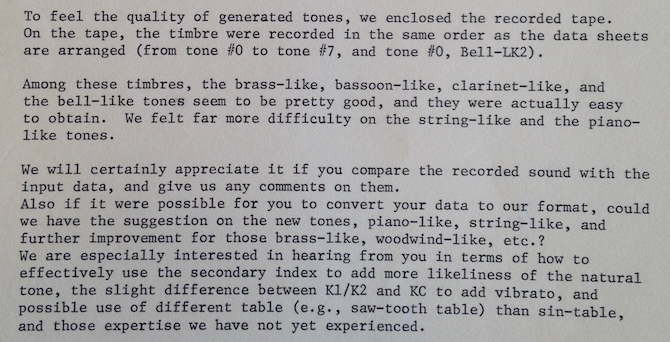
Yamaha’s progress update on the synth tones; Stanford Special Collections Library
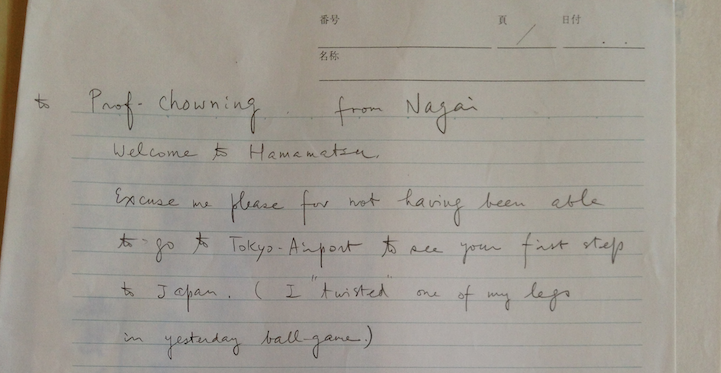
Some friendly correspondence: Yamaha welcoming Chowning to Japan for the first time; Stanford Special Collections Library
While Yamaha tinkered with digital synthesizer technology, they made great strides with their analogue synths. In 1975 and 1976, the company released two machines — the GX1, and the CS80 — in limited runs of 10 units. Despite their $50,000 price tags , they were snatched up by the likes of Keith Emerson, John Paul Jones (Led Zeppelin), Stevie Wonder, and ABBA, and were lauded as “Japan’s first great synths.”
As Yamaha got closer to creating the first digital synthesizer in 1977, Stanford’s application for the FM synthesis patent was finally approved. By then, Yamaha was fully invested in the belief that the technology could make them millions of dollars, and they negotiated a licensing agreement with Stanford, securing them rights to the technology for the next 17 years, until 1994.

One of 17 schematics submitted in the FM Synthesis patent application (submitted in 1974, and approved in 1977)
But during the next several years, the company hit a number of roadblocks in rolling out their digital technology. “Yamaha,” wrote English music magazine, SOS, “is floating into the backwaters of the professional keyboard world.”
Somewhere in this lull, a tiny Vermont-based synthesizer company aptly named the New England Digital Corporation beat Yamaha to the punch by producing the world’s first digital synthesizer, the “Synclavier.” Though only 20 units were sold at $41,685 each, and they were all reserved for top-notch musicians, Stanford took no chances, and swiftly sued the company for infringing on its FM synthesis patent. From that point forward, the university received a sum of $43 every time a Synclavier was sold.
In 1981, Yamaha finally succeeded in integrating Chowning’s FM synthesis into an instrument. Like their previous synths, the GS-1 and GS-2 were ridiculously expensive — some $15,000 each — and were only produced in limited runs for world-famous performers like Toto. But the instruments were universally touted as great sounding, which boded well for Yamaha.
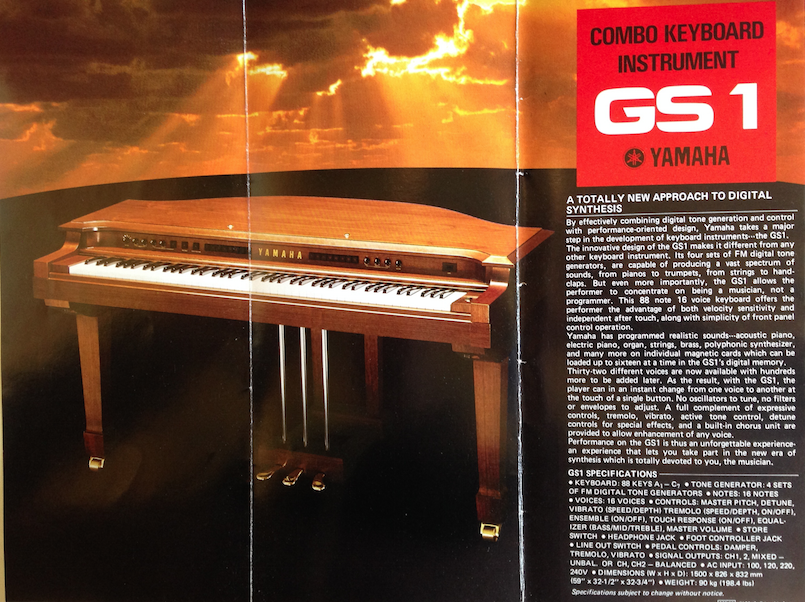
A GS-1 ad from 1981; they retailed for around $15,000 each
“Yamaha always seemed to make the first product a high-end product,” says Chowning. “They tried to set the highest audio standard at the onset, so that the following products would have a good name, the existing tech will be easier to roll out.”
According to Chowning’s premonition, Yamaha would release a more accessible synth two years later — and it would “turn the music world upside down.”
***
In a 1981 progress report to Chowning, Yamaha’s Advanced Development Division made its intentions clear: “To [achieve] better sales, our next model should not be an improvement of the electronic piano, but rather be a new attractive type of keyboard instrument.” Instead of emulating existing instruments, the company would create and market a distinctly new one.
When Yamaha engineers released the “DX7” in May of 1983, they knew they had done just that. The keyboard fully integrated all of the capabilities of Chowning’s FM synthesis on a small Intel 3000 chip, was sleek, and, unlike its predecessors, was more within reach to the general public.
At a price point of $1,995 USD, the DX7 featured 16-note polyphony (meaning that 16 keys could be played simultaneously), and allowed the user to program up to 32 of his own custom sounds. Though it was mass produced for a wider audience, its sound quality earned it high praise from a number of famous musicians: Elton John, Stevie Wonder, Queen, U2, Phil Collins, Kraftwerk, Talking Heads, Enya, Brian Eno, Yes, Supertramp, Steve Winwood, Depeche Mode, The Cure, Toto, Michael McDonald, Chick Corea, Lynyrd Skynyrd, Beastie Boys, and Herbie Hancock included.
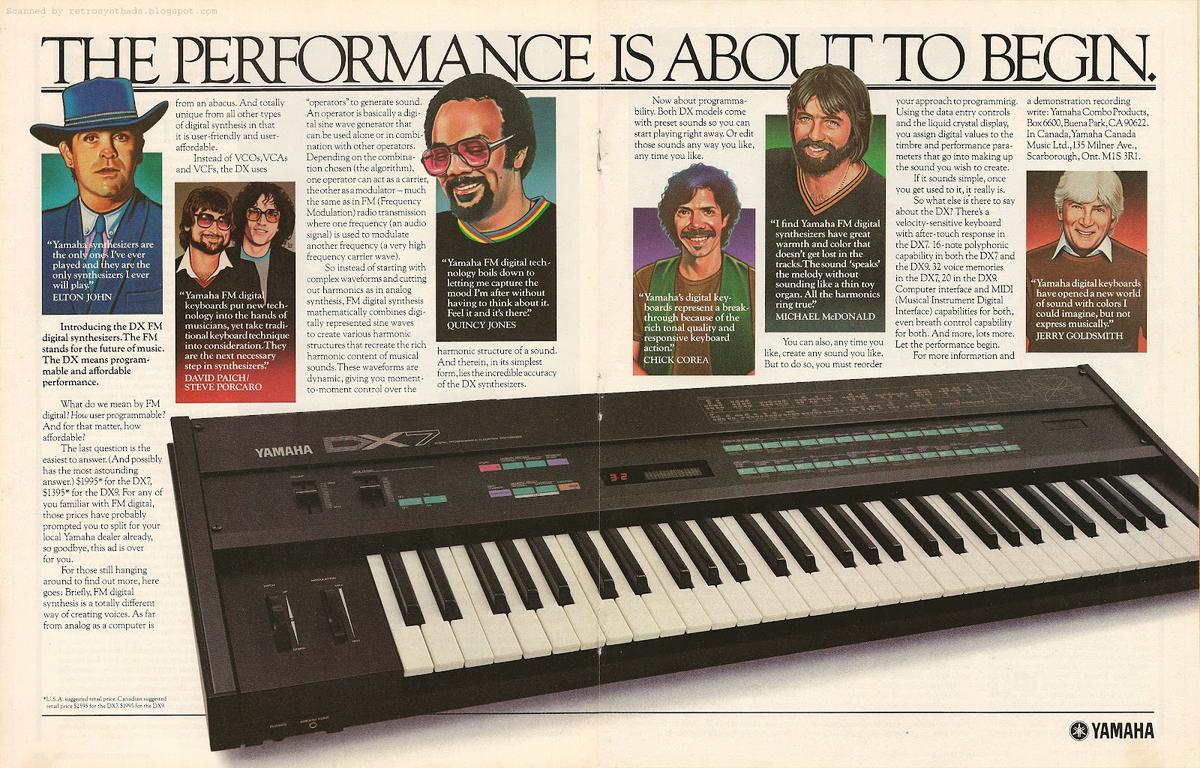
A vintage ad for the DX7, featuring testimonials from Elton John, Chick Corea, and Michael McDonald, among others (1983)
From its onset, the DX7 was a massive success — one that both Stanford and Yamaha minted money from.
Royalty records in the Stanford archives show that from May 1983 to October 1983 alone, Yamaha raked in some $39,913,067 (roughly $92,868,000 in 2015 dollars) in DX7 sales. As per the original licensing agreement, Stanford received .5% of the grand total, or $199,565 ($468,270). And this was just from the product’s first six months on the market.
In the next six-month cycle, from November 1983 to April 1984, Stanford’s royalty increased to $287,500 ($674,606). A December 18, 1984 letter Stanford to Yamaha reveals that the school was making substantially more than $1 million per year off of the FM synthesis patent and its relationship with Yamaha.
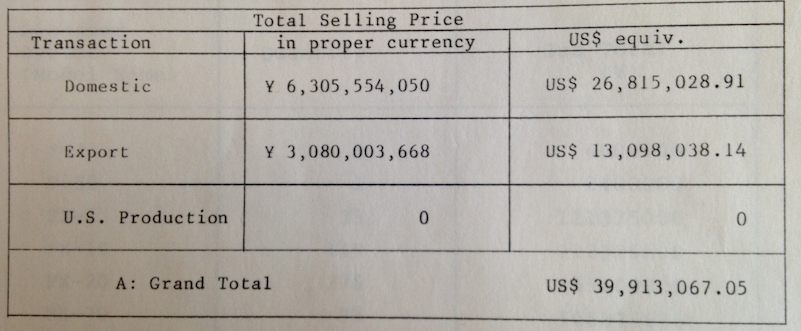
Revenue reports from Yamaha; Stanford Special Collections Library
For a brief time — before the meteoric rise of genetic engineering and the Internet — FM synthesis was Stanford’s highest-grossing patent in the school’s history. The synthesizer exploded in popularity in a variety of markets (the U.S, Japan, Great Britain, and France) and continued to bring in substantial profits through its discontinuation in 1986.
Yamaha’s market share for pianos in Japan jumped from 40% in 1980 to more than 65% by 1985; its closest rival, Kawai, trailed far behind at 22%. The company, once focused on diversification, now intensely drove its synthesizer production, producing some 1,000 electronic organs per day. The DX7 became the world’s best-selling synthesizer, and demandes were so high that it had a two-year backorder.
“I’m sure there are many people who wish I didn’t exist at the time,” laughs Chowning. “So many competing companies had to close down — they simply couldn’t compete with the DX7.”
The Prince of CCRMA
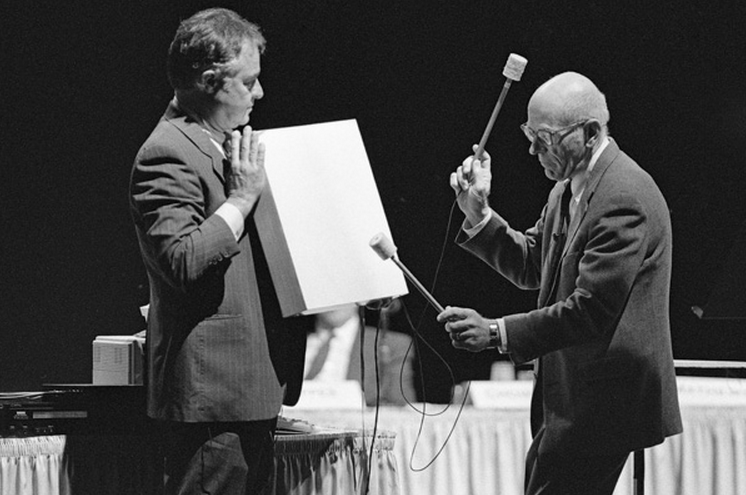
Chowning with Max Mathews (c.1990)
Though the DX7’s success paid off the most for Yamaha and Stanford, Chowning was duly rewarded for his role.
Dismissed from the staff just a few years before, he was now given full tenure with a “healthy” professor’s salary. “I'm probably the only person in the history of Stanford, or most universities, who, within the same university, went from assistant professor to full professor without being appointed associate professor,” says Chowning. “In a way, that’s vindication.”
Stanford’s patent royalty distribution worked as follows: 15% would be taken off the top for the OTL’s “tech budget,” out of pocket expenses would be deducted, and the rest would be distributed to Stanford’s general fund, the inventor’s department, and the inventor himself in “equal sums.”
Though the discovery wasn’t as lucrative for Chowning as it was for Stanford, the professor reaped rewards in other forms. Records in Stanford’s special collections library show that from 1984 to the early 1990s, he was making as much as $600 per day consulting Yamaha on its technologies.
What’s more, his department, CCRMA, was moved to what Chowning calls “the most beautiful building on campus” — a princely, 100-year-old Spanish Gothic building perched atop a hill, and once inhabited by the university’s president. Of course, Yamaha decked it out with more than $18,000 of instruments and music equipment.
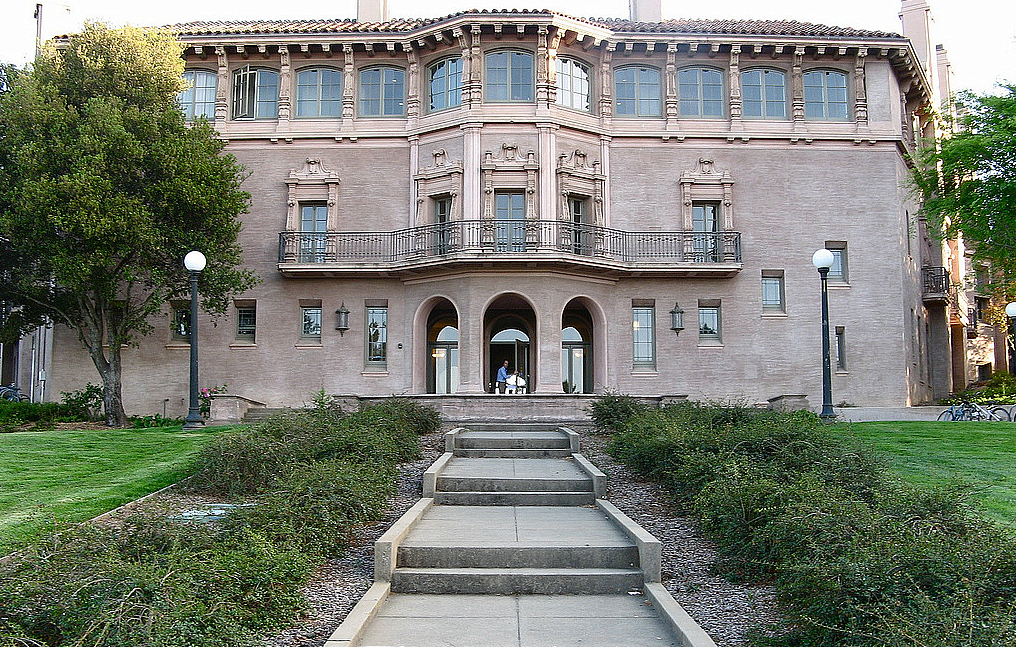
The "Knoll," damaged in the Loma-Prieta earthquake of 1989 and restored in 2005, is home to John Chowning’s CCRMA department.
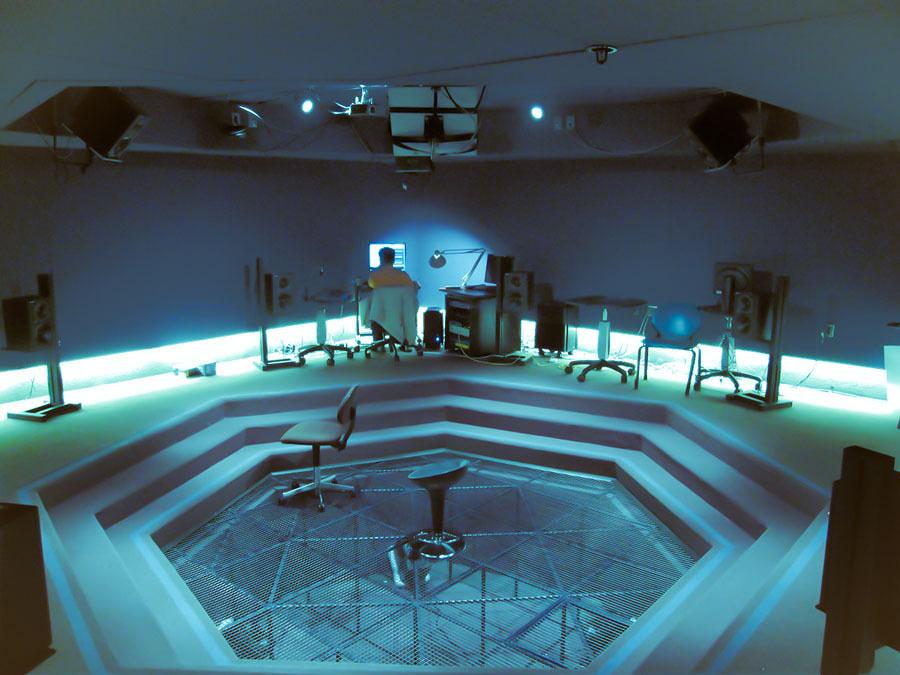
Inside CCRMA’s “Listening Room”
Whereas the music department had once ousted Chowning for his “strange” concepts, it now embraced him as a cult hero: by the mid-1980s, nearly every graduate student composer at Stanford was making use of a computer.
Chowning had brought Stanford more than a steady stream of revenue; he’d brought them prestige. In the midst of synthesizer developments in 1977, Chowning had traveled back to Paris’s IRCAM — by then, the world’s biggest digital music research center — and presented a new work, “Stria.” The piece was groundbreaking in many ways. Written using SAIL, a new language developed by Stanford’s Artificial Intelligence Lab, it was among the firstcompositions to be fully generated by a computer, and to integrate elements from the golden mean and the Fibonacci sequence. If Chowning had any doubters at this point, they certainly didn’t make themselves known.
In the mid-1980s, Chowning’s FM chips were implemented as a soundcard component in PCs, phones, and consoles; Atari, NEC, Fujitsu, Sharp, and Sega all enlisted the technology to produce MIDI sounds. The patent was making more money than ever before — and at the height of this second wave, Stanford and Yamaha signed a new royalty agreement: 1.5% of the sale of each instrument would be collected by the OTL, up from .5%.
Records show that Stanford raked in FM patent royalties of $1.56 million for the 1986-7 fiscal year; by 1992, this number was $2.7 million — at that time, the second most lucrative patent at Stanford, trailing only genetic engineering. The FM chip, which Yamaha had developed with Chowning, was selling some 736,000 pieces per year. One Canadian company alone was purchasing 20,000 of them a month for use in “black boxes with MIDI inputs.”
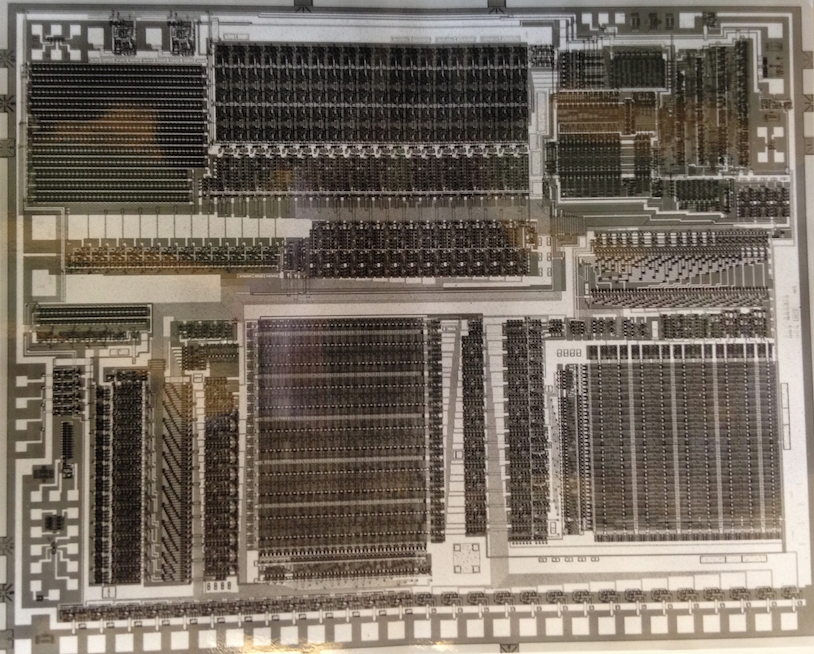
An FM chip; Stanford Special Collections Library
By 1989, Julius Orion Smith, one of Chowning’s younger colleagues, had developed another form of synthesis based around physical modeling, or the use of mathematical models to simulate sound. Yamaha licensed this technology as well, and soon, the Stanford-Yamaha partnership was so strong that they decided to “pool their portfolio of patents” and formSondius-XG, a mutually-beneficial investment group that brought both parties considerable wealth over the years.
Throughout all of this, Chowning remained level-headed, if not disinterested.
“I never had the idea that this was going to be a big money-maker for Stanford,” he says. “My interest was never in patenting; my interest was in using it in my compositions, my own music.”
When he retired in 1996, Chowning had enough influence to secure two professorships in his program — one for Julius O. Smith, and the other for Chris Chafe. In later years, Chafe took the reigns from Chowning as the center’s director, expanding its disciplines to include composition, electrical engineering, computer science and neuroscience. “He’s added three additional professors to the faculty, seven consulting professors, and two staff/lecturer positions — not an easy task,” Chowning relates. “The teaching/research program has grown by a factor of three.”
***
Today, John Chowning is regarded as one of electronic music’s great pioneers — one who braved the critical gaze to realize his dreams and change the landscape of sound. But Chowning doesn’t put much stock in his technological breakthroughs: he’s a composer at heart, a man interested more in explorative composition than prestige.
“I don’t think of myself as an inventor,” he admits, scanning across the Stanford hills from one of CCRMA’s studios. “My head space is a composer: the inventions were simply a result of a compositional search, a musical idea.”
But it’s still hard to ignore the impact of Chowning’s accomplishments. Nearly forty years after its issuance, his FM synthesis patent has made Stanford a cool $25 million. It has, along with Chowning’s creative spirit, led to the creation of one of the finest digital music centers in the world — one that designs the sound structure of opera houses, and does “acoustic archeology” on pre-Incan ruins.
Above all else, Chowning loves to learn. Occasionally, the 80-year-old will sit down with his 28-year-old son, a classical French horn player, and study “club” music. “I listen to him when he tells me to listen to music,” he says. “Glitch music, that’s great stuff. Good subwoofer pumps. You’re never too old to explore sounds.”
It’s a mantra he’s taken to heart. In his youth, Chowning would hike into the mountains to yell in caves and listen to the echoes; all these years later, he hasn’t lost touch with the world’s acoustic wonders.
“There’s an underground tunnel in Palo Alto where kids ride their bicycles and shout,” he says. “Adults don’t do it because they’re too self-conscious — but every time I pass through, I can’t help myself. You can only do it once, because people get agitated. It sounds like music to me.”
This post was written by Zachary Crockett. You can follow him on Twitter here.

No comments:
Post a Comment